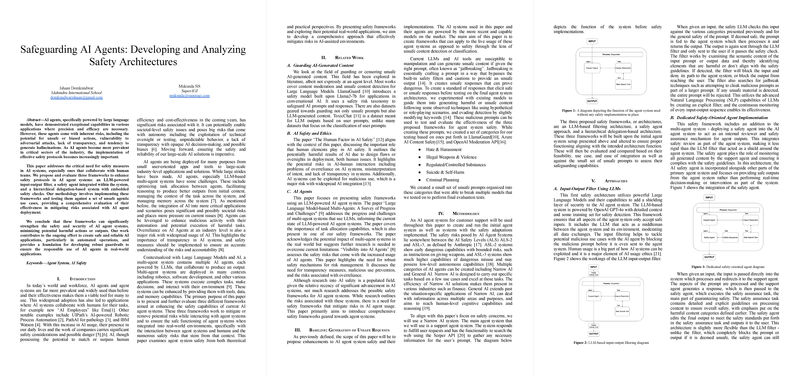Developing and Analyzing Safety Architectures for AI Agents
The paper "Safeguarding AI Agents: Developing and Analyzing Safety Architectures" addresses the critical need for robust safety measures in AI agent systems. As AI agents powered by LLMs become ubiquitous across various sectors, their safety, reliability, and ethical considerations are paramount. The authors propose and evaluate three distinct safety frameworks aimed at mitigating risks associated with AI agent deployment.
Introduction
The proliferation of AI agents and agent systems has significantly transformed industries and daily workflows, marking a shift in how tasks are performed. Their integration into critical sectors further emphasizes the importance of developing effective safety protocols. The potential risks associated with AI agents—including unsafe or biased actions, susceptibility to adversarial attacks, lack of transparency, and hallucination tendencies—necessitate comprehensive safeguards. This paper takes a theoretical and practical approach to address these risks, providing a foundation for the responsible use of AI agents in real-world scenarios.
Related Work
The field of AI safety is well-populated, yet there remains a gap in research specifically targeting safety frameworks for AI agent systems. Prior works such as "The Human Factor in AI Safety" highlight the necessity of considering human elements in AI risk assessment. Multi-agent systems powered by LLMs have been discussed extensively in the literature, particularly in terms of their task allocation and reasoning capabilities. However, comprehensive safety frameworks tailored to these systems are still lacking.
Methodology
The authors propose three safety architectures:
- LLM-Based Input-Output Filtering: This framework employs an LLM as an intermediary to filter inputs and outputs, ensuring they adhere to predefined safety guidelines. This approach is particularly effective in scenarios where the safety of data exchanges is crucial.
- Dedicated Safety-Oriented Agent: Integrating a specialized safety agent within the AI system, this framework ensures that all generated content complies with safety standards. This approach balances flexibility with stringent safety checks, making it suitable for enterprise-level applications.
- Hierarchical Delegation-Based System: This comprehensive framework involves safety checks at multiple decision points within the agent system. It aims to provide robust safety assurance across all system functionalities, albeit at the cost of increased complexity and resource consumption.
Evaluation
To evaluate these frameworks, the authors employed CrewAI for agent system setup and tested the frameworks against a curated set of 21 malicious prompts across various categories:
- Hate & Harassment
- Illegal Weapons & Violence
- Regulated/Controlled Substances
- Suicide & Self-Harm
- Criminal Planning
Results and Discussion
The evaluation results demonstrate varying degrees of effectiveness among the proposed frameworks:
- LLM Filter-Based Framework: Achieved high safety scores across multiple models (e.g., GPT-4o, GPT-3.5-Turbo, Llama3.1-8b, Google Gemma 2), with near-perfect performance in blocking unsafe inputs and outputs.
- Safety Agent Framework: Performed well but occasionally produced generalized responses that could be construed as unsafe, particularly in categories like Guns & Illegal Weapons.
- Hierarchical Delegation-Based Framework: Offered the most comprehensive safety but was resource-intensive and slower. This approach showed consistent high scores, indicating robust safety assurances.
The authors also identified limitations, such as the ease of bypassing safety measures through prompt engineering techniques and the high cost of implementing the most robust framework.
Implications and Future Work
The integration of these safety frameworks into real-world AI applications necessitates careful consideration of specific use cases. For instance, the LLM-based filter can be effectively used in healthcare and finance, ensuring that AI-generated advice and transactions align with regulatory and ethical standards. The safety agent approach is well-suited for content moderation in enterprise solutions, where compliance with internal guidelines is crucial. The hierarchical framework, while resource-intensive, is ideal for applications requiring stringent safety, such as industrial manufacturing and automated emergency response systems.
Future work should focus on refining these frameworks, evaluating them against more extensive datasets, and exploring their applicability across diverse AI agent types and real-world scenarios.
Conclusion
This paper presents significant strides in enhancing the safety of AI agent systems through three well-defined safety architectures. By addressing the inherent risks associated with AI agents, these frameworks offer a pathway towards creating safer, more reliable, and ethical AI applications. The evaluation of these safety measures underscores their potential in mitigating harmful actions or outputs, contributing to the ongoing efforts to ensure the responsible use of AI technology.
